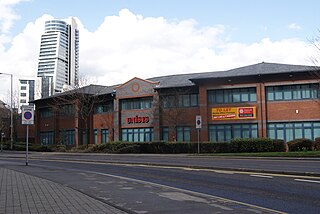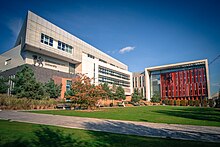Related Research Articles

The West Midlands Metro is a light-rail/tram system in the county of West Midlands, England. The network has 31 stops with a total of 14 miles (23 km) track; it currently consists of a single route, Line 1, which operates between the cities of Birmingham and Wolverhampton via the towns of Bilston, West Bromwich and Wednesbury, on a mixture of former railway lines and urban on-street running. The system is owned by the public body Transport for West Midlands, and operated through Midland Metro Ltd, a company wholly owned by the West Midlands Combined Authority.

Birmingham City University is a university in Birmingham, England. Initially established as the Birmingham College of Art with roots dating back to 1843, it was designated as a polytechnic in 1971 and gained university status in 1992.

Millennium Point is a multi-use meeting and conference venue, public building and charitable trust in Birmingham, England, situated in the developing Eastside of the city centre. The complex contains multiple event spaces, including a 354-seat auditorium, formerly Giant Screen IMAX cinema; Birmingham Science Museum, Royal Birmingham Conservatoire's School of Acting and Birmingham City University's Faculty of Computing, Engineering and The Built Environment, part of Birmingham Metropolitan College.

Birmingham is a major transport hub, due in part to its location in central England. The city is well connected by rail, road, and water. Public transport and key highways in the city are overseen by Transport for West Midlands (TfWM).

The Big City Plan is a major development plan for the city centre of Birmingham, England.

Masshouse is a development site in Birmingham, United Kingdom where 13 highrise blocks are being constructed for public services, commerce and residential purposes. When completed, the blocks will have a prominent position on the Eastside skyline.
Glenn Paul Howells is a British architect and a director and founder of Howells.

Eastside is a district of Birmingham City Centre, England that is undergoing a major redevelopment project. The overall cost when completed is expected to be £6–8 billion over ten years which will result in the creation of 12,000 jobs. 8,000 jobs are expected to be created during the construction period. It is part of the larger Big City Plan project.

The Gateway Plus project was a redevelopment scheme that regenerated Birmingham New Street railway station and the Pallasades Shopping Centre above it in Birmingham, England. It was completed in September 2015. The project aimed to enhance the station to cope with increased passenger numbers as well as expected future growth in traffic, but did not alter the train capacity of the station. In 2008, the station handled passenger numbers far in excess of the capacity of its existing design. The current station and Pallasades Shopping Centre were completed in 1967 and became the subject of criticism for the congestion of the station and shabbiness of the shopping centre and parts of the station. It is part of the Big City Plan.

Curzon Gate was a residential development located on the edge of Birmingham City Centre, West Midlands, England, on a prominent gateway site into the city centre. The land was formerly occupied by Castle Cement silos. The 4-acre (1.6 ha) site was located in the Eastside area, which is currently witnessing a large-scale regeneration scheme. It was located next to Curzon Park and opposite Eastside Locks, both of which are developments. It was bounded by a railway viaduct to the south and a road junction on the A4540 road. It was separated from Curzon Park by the Digbeth Branch Canal.

High Speed 2 (HS2) is a planned high-speed railway line in England, the first phase of which is under construction in stages and due for completion between 2029 and 2033, depending on approval for later stages. The new line will run from its southern terminus in London to its most northerly point, Manchester, with branches to Birmingham and the East Midlands. HS2 will be Britain's second purpose-built high-speed line, the first being High Speed 1, which connects London to the Channel Tunnel.

The Faculty of Computing, Engineering and the Built Environment is the technology department of Birmingham City University, England, covering engineering programmes. It is located in the City Centre campus in the eastern half of the Millennium Point complex. Spanning five stories of the £114 million complex in the developing Eastside district, the centre offers courses in undergraduate and postgraduate education.

Birmingham city centre, also known as Central Birmingham is the central business district of Birmingham, England. Following the removal of the Inner Ring Road, the city centre is now defined as being the area within the Middle Ring Road. The city centre is undergoing massive redevelopment with the Big City Plan, which means there are now nine emerging districts and the city centre is approximately five times bigger.

Eastside City Park is a 6.75 acre urban park located in the Eastside district of Birmingham City Centre. Designed by architects Patel taylor with landscape architect Allain Provost, the park was opened to the public on 5 December 2012 at a cost of £11.75 million. Lining the frontage of Millennium Point, the park provides 14,300 square metres of landscaped green space, 310 trees, a 110 metres (360 ft) canal water feature and a public square incorporating 21 jet fountains.

Birmingham Curzon Street railway station is the planned northern terminus of Phase 1 of High Speed 2 in the city centre of Birmingham, England. The new railway will connect Birmingham to London Euston via Birmingham Interchange and Old Oak Common. Curzon Street will have seven terminal platforms and is planned to open in 2026.

Birmingham Metropolitan College is a further and higher education college with 10 campuses distributed within Birmingham, England. The college was created in 2009 as an amalgamation of Matthew Boulton College and Sutton Coldfield College. The main site is Matthew Boulton College based at Jennens Road in Birmingham City Centre.

The Library of Birmingham is a public library in Birmingham, England. It is situated on the west side of the city centre at Centenary Square, beside the Birmingham Rep and Baskerville House. Upon opening on 3 September 2013, it replaced Birmingham Central Library. The library, which is estimated to have cost £188.8 million, is viewed by the Birmingham City Council as a flagship project for the city's redevelopment. It has been described as the largest public library in the United Kingdom, the largest public cultural space in Europe, and the largest regional library in Europe. 2,414,860 visitors came to the library in 2014 making it the 10th most popular visitor attraction in the UK.

Leeds New Lane was a proposed new railway station to accommodate High Speed Two rail services in West Yorkshire, England. It was planned to be constructed on a viaduct on New Lane south of Leeds city centre, the River Aire and Leeds City station to which it would be connected by an elevated walkway. The site is occupied by Central Park, a small low-rise office park built in the 1990s and other small office buildings.

Paradise, formerly named Paradise Circus, is the name given to an area of approximately 7 hectares in Birmingham city centre between Chamberlain and Centenary Squares. The area has been part of the civic centre of Birmingham, England since the 19th century when it contained buildings such as the Town Hall, Mason Science College, Birmingham and Midland Institute buildings and Central Library. The site was redeveloped from 1960 to 1975 into the present Paradise Circus based within a roundabout on the Inner Ring Road system containing a new Central Library and School of Music. From 2015, Argent Group will redevelop the area into new mixed use buildings and public squares.
References
- ↑ "University to showcase £150m eastside plans". Archived from the original on 12 June 2008. Retrieved 30 May 2008.
- ↑ "Archived copy" (PDF). Archived from the original (PDF) on 19 July 2011. Retrieved 2 January 2009.
{{cite web}}: CS1 maint: archived copy as title (link) - ↑ Margaret Street not closing
- ↑ "High-speed rail plans announced". 11 March 2010.
- ↑ "Birmingham City University : University pledges to deliver vision for city centre campus". Archived from the original on 23 May 2010. Retrieved 22 March 2010.
- ↑ "Birmingham Newsroom".
- ↑ http://www.regen.net/news/ByDiscipline/Business/1003998/Birmingham-City-Council-names-Eastside-architects/ [ dead link ]
- ↑ "Sunday Mercury - Latest news updates, pictures, video, reaction - Birmingham Live".
- ↑ "Birmingham Post - News - West Midlands News - New Birmingham magistrates court planned for Eastside falls victim to cuts". Archived from the original on 25 September 2012. Retrieved 19 June 2010.
